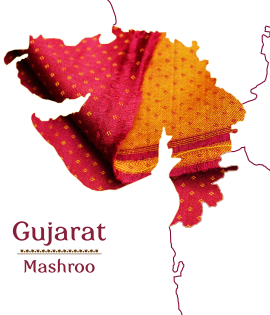
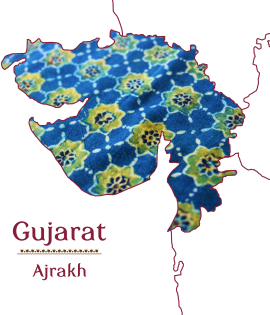
Ajrakh
One of the most specialised and finest kind of block printing, Ajrakh is a popular traditional art form of Kutch. A length and detailed, highly skilled process is part of the creation of a fine Ajrakh print involving resist printing and indigo dye.
The entire process of printing Ajrakh thus involves 13 stages that are inevitably more expensive to produce, but the result is a wonderful depth of colour not achievable with surface printing.
Patola
Patola is a double ikat woven sari, usually made from silk, made in Patan, Gujarat, India. The word Patola is the plural form of Patulu. They are very expensive, once worn only by royalty and the aristocracy, they are popular and in-demand from those who can afford them.
Patola has a royal history. Silk weavers of the Salvi caste from the states of Karnataka and Maharashtra chose Gujarat as the home for their renowned patola fabric. It is said that this technique is taught to no one in the family, but only to the sons. It can take six months to one year to make one sari due to the long process of dying each strand separately before weaving them together. Patola was woven in Surat, Ahmedabad, and Patan. Highly valued in Indonesia, became part of the local weaving tradition there.
Patola has a royal history. Silk weavers of the Salvi caste from the states of Karnataka and Maharashtra chose Gujarat as the home for their renowned patola fabric. It is said that this technique is taught to no one in the family, but only to the sons. It can take six months to one year to make one sari due to the long process of dying each strand separately before weaving them together. Patola was woven in Surat, Ahmedabad, and Patan. Highly valued in Indonesia, became part of the local weaving tradition there.
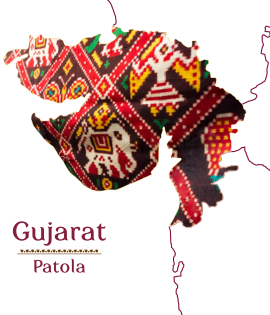
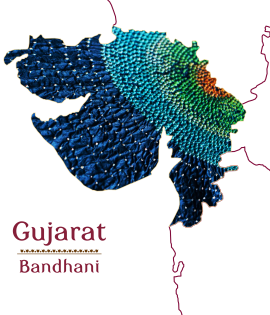
Bandhani
Bandhani, also known as Bandhej; is a type of tie and dye textile which is adorned by plucking the cloth into many bindings that form a design.
Bandhani is symbolic of the heritage of the desert state. Bandhani isn’t just an art or a fabric, it is a whole emotion, one that is full of the most vivid hues of our rich culture. Besides being one of the most sparkling jewels in the crown of Rajasthani handicrafts, Bandhej is also popular in the states of Gujarat, and parts of Uttar Pradesh as well.
Bandhani is symbolic of the heritage of the desert state. Bandhani isn’t just an art or a fabric, it is a whole emotion, one that is full of the most vivid hues of our rich culture. Besides being one of the most sparkling jewels in the crown of Rajasthani handicrafts, Bandhej is also popular in the states of Gujarat, and parts of Uttar Pradesh as well.
Bhujodi
Kutch and Bhuj have been home to weavers for centuries– for generations. The Bhujodi weave is different because it was traditionally done in wool, using a pit loom with natural dyes.
Today, the geometric designs have attracted textile lovers who have pushed for converting these Bhujodi weaves into sarees. Bhujodi weavers have adapted to this change, and well.
Today, the geometric designs have attracted textile lovers who have pushed for converting these Bhujodi weaves into sarees. Bhujodi weavers have adapted to this change, and well.
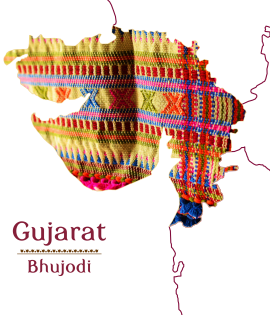
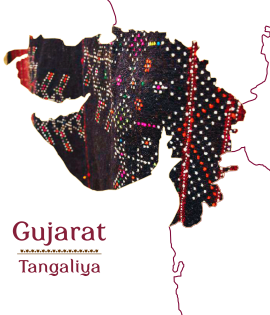
Tangaliya
Tangaliya weaving, also known as Daana weaving is practiced in Gujarat. Tiny dots of extra weft are twisted around a number of warp threads, giving an effect of bead embroidery to the fabric. This intricate process of twisting extra weft while weaving creates beautiful geometrical patterns and forms. The essence of Tangaliya weaving is the compositions created by colorful dots, which are simultaneously created on both sides of the fabric.
Mashroo
The Mashroo textile is a vivacious, handwoven mix of silk, and cotton fabrics. Mashroo material is created using satin weave by interlacing silk, and cotton yarns. Cotton creates the weft, or the horizontal yarns, while silk is utilized for the warp or the vertical yarns. In this structure of weave, each silk yarn goes under one cotton yarn, and above five to eight or more cotton, giving the look of a shiny surface that seems like it is made up of only silk, while the underside of the cloth is cotton.
